What to do and what not to do!
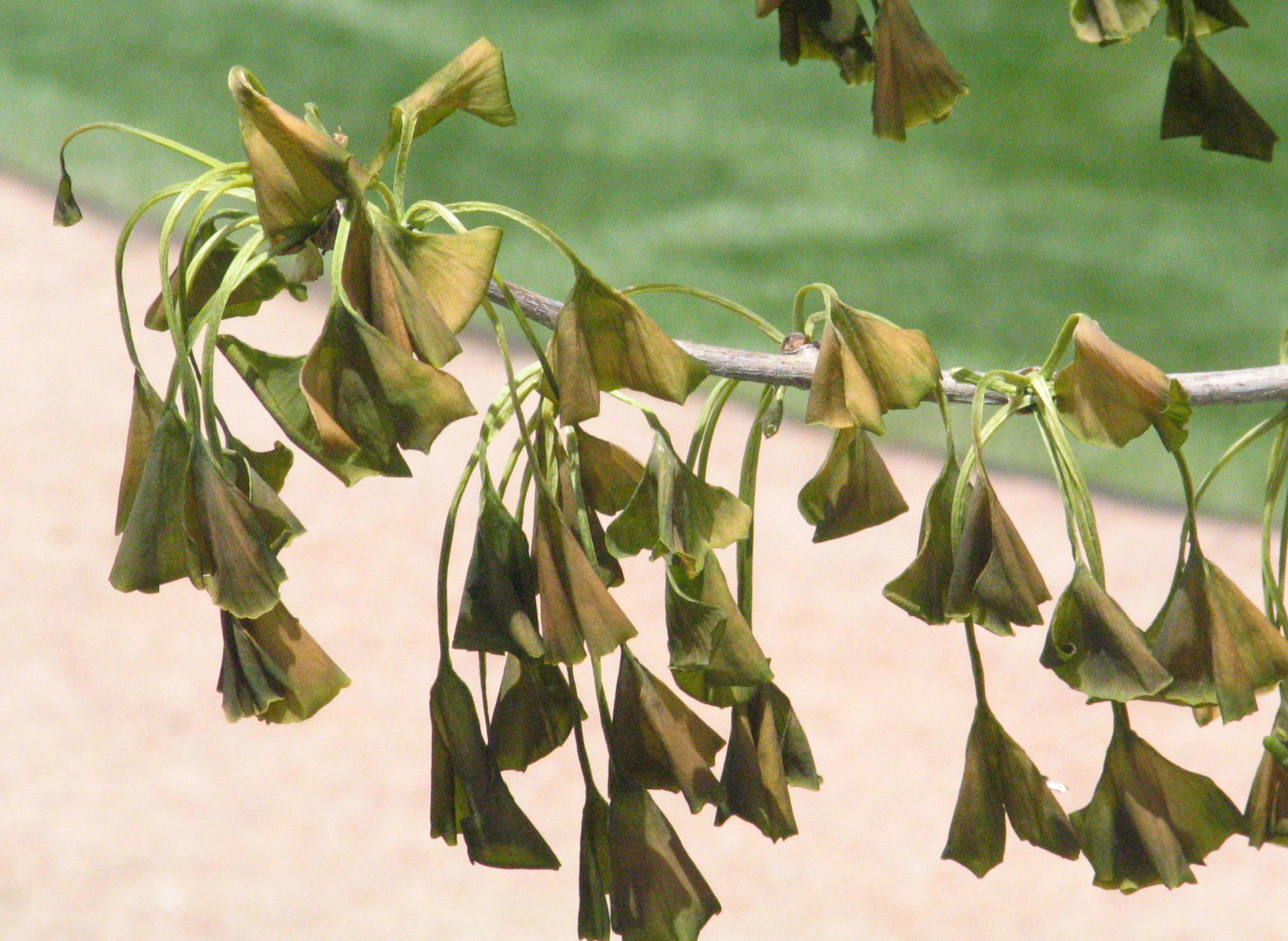 I
am a retired fruit grower from upstate New York. In addition to our
orchards we grew approximately 30 acres of strawberries and had them under solid
set irrigation. In addition to strawberries insatiable need for water
during the fruiting season we used this irrigation system for frost control.
Most of us have seen sprinklers on the news being used by farmers on cold nights
and unfortunately this has led to serious misconceptions and in many cases
damage to plants and fruit that may not have occurred with these
misconceptions.
I
am a retired fruit grower from upstate New York. In addition to our
orchards we grew approximately 30 acres of strawberries and had them under solid
set irrigation. In addition to strawberries insatiable need for water
during the fruiting season we used this irrigation system for frost control.
Most of us have seen sprinklers on the news being used by farmers on cold nights
and unfortunately this has led to serious misconceptions and in many cases
damage to plants and fruit that may not have occurred with these
misconceptions.
Of course a small amount of plants
in pots can be easily moved under
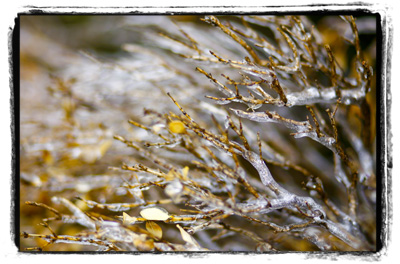 cover and don't forget Fido. A few
plants can also be covered, but if you use plastic try to keep the plastic from
touching the plants. You can figure this out, I am sure.
cover and don't forget Fido. A few
plants can also be covered, but if you use plastic try to keep the plastic from
touching the plants. You can figure this out, I am sure.
So if you would like to know some of the more technical aspects of saving your plants from damage and/or complete annihilation read on and believe it or not watering at the wrong time and shutting it off too soon can lead to disaster.
A fact
Relative humidity is how much moisture a given volume of air holds and this is relative to the temperature of it. Warm moist air holds more heat than dry air. Same thing holds for soil and within the plants themselves.
Dehydration
Moist condition can not only enhance a plants ability to ward off the damage of freezing as freezing a plants cells leads to expansion and death. How would you like the cells in your body to be expanded and not be able to reconstitute? There are tropical plants such as succulents that suffer in temperatures above the freezing mark. Coleus for one and wetting the soil and foliage during these periods following our practices below will help these plants make it. Depleting the moisture within a plant is no different than what we humans suffer and that is dehydration. I read recently that most people suffer from one degree of dehydration or another.
Water/Heat
 When water is applied to plants during frosty nights the heat in
the water will protect the plants and fruit, this is why the farmers and smart
gardeners do it. When we say heat in the water we are talking about the
difference between the temperature of municipal water usually around 50 degrees
F
and ground temperature of lets say 30 F degrees. (Water out of an irrigation
pond would most likely be cooler, but not much) The difference has to go
somewhere, as the water freezes the difference is released into the air, olla. This latent heat, heats
the field/garden.
When water is applied to plants during frosty nights the heat in
the water will protect the plants and fruit, this is why the farmers and smart
gardeners do it. When we say heat in the water we are talking about the
difference between the temperature of municipal water usually around 50 degrees
F
and ground temperature of lets say 30 F degrees. (Water out of an irrigation
pond would most likely be cooler, but not much) The difference has to go
somewhere, as the water freezes the difference is released into the air, olla. This latent heat, heats
the field/garden.
We have seen strawberry fields go from 28 degrees to 37 degrees 15 minutes after turning on our pumps. That is what us called latent heat and that latent heat gave us a strawberry crop year after year as we are talking blossom time as the picture below.
The weather man will tell you that the coldest temperature will be right at ground level (cold drops, heat rises) and this is why the water will turn to ice on the plants first, if the ambient air is cold enough.
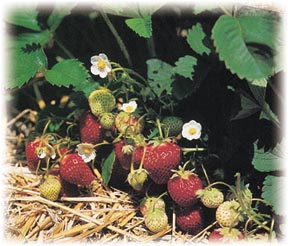
Now these principles if used properly can save your plants and fruit and reduce wind and cold damage even if frost is not encountered. Cold winds dehydrate plants, therefore added moisture protects the plants.
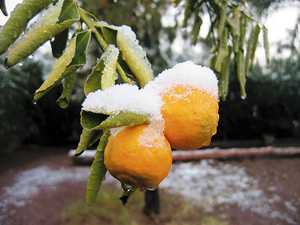 Some
days before an impending cold spell we have a clash of the cold air hitting the
warm air and we encounter precipitation. This is a God send and may
explain little damage the night of a recent cold spell. If you get a couple of days of wind after this precipitation you are back in the danger zone. Again, soil that
is wet attracts more heat from the daytime air the day or two before an
impending frosty night, almost like a reservoir.
Some
days before an impending cold spell we have a clash of the cold air hitting the
warm air and we encounter precipitation. This is a God send and may
explain little damage the night of a recent cold spell. If you get a couple of days of wind after this precipitation you are back in the danger zone. Again, soil that
is wet attracts more heat from the daytime air the day or two before an
impending frosty night, almost like a reservoir.
There are times where it doesn't rain and the plants are more vulnerable.
The hose
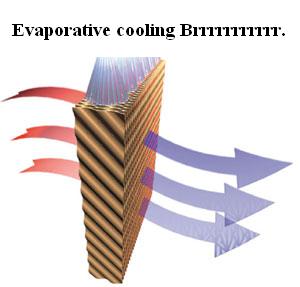 Now using this principle do you get
the hose out the evening before a frost, not all of the time, read on.... They say that you can make ice in
a desert on a 40 degree night, if you set up conditions with the help of a
breeze using the principles of evaporative cooling. In this case if you applied water at the wrong time you could be encouraging evaporative cooling.
Now using this principle do you get
the hose out the evening before a frost, not all of the time, read on.... They say that you can make ice in
a desert on a 40 degree night, if you set up conditions with the help of a
breeze using the principles of evaporative cooling. In this case if you applied water at the wrong time you could be encouraging evaporative cooling.
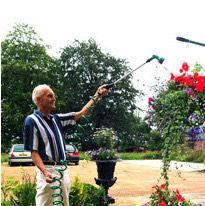 Now on the other hand if you do not
expect rain, do you get the hose out the day before an impending frost or the
morning of the day before a night of frost, yes.
Now on the other hand if you do not
expect rain, do you get the hose out the day before an impending frost or the
morning of the day before a night of frost, yes.
During cold weather keep your soil and foliage and that includes bushes and small trees wet and take advantage of the heat that is available during the day. When watering early in the day and as we know moisture holds more heat than dry between the warmth of the water and the cumulative heat of the day these conditions will store heat and emanate during the night and morning of a frost.
Again don't water that evening after you see the weatherman showing farmers getting ready to irrigate their crops, from old tapes. You see a farmer irrigating his crops at 9 P.M. on the evening news of an impending freeze and if you go out with your hooded jacket on and start watering everything, you are making a big mistake especially if you intend to turn the water off.
Now if the temps really get down in the early morning than you have to play farmer with your sprinklers and I don't know how this is going to wash with water restrictions, that is not my problem. You can go to an agricultural supply house and ask for mist sprinkler heads
to replace the ones that you use normally. This will cut down on water
usage, it will still give you that latent heat release, it will cut down on
flooding your plants as you don't want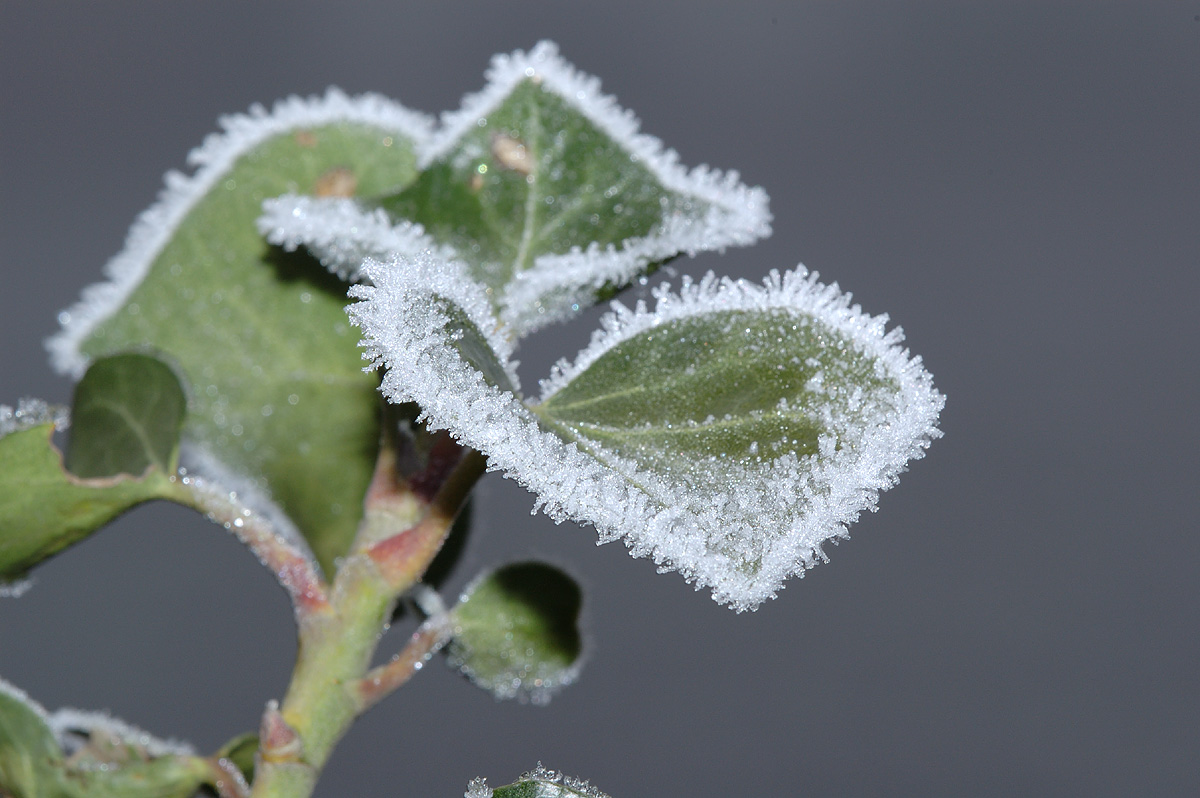 to do that and it will extend added
pressure and coverage to multiple sprinklers, if you have a fairly large
area to cover.
to do that and it will extend added
pressure and coverage to multiple sprinklers, if you have a fairly large
area to cover.
Ice
Now this is an important fact and this is coming from someone that made a living doing this stuff and learned a few unfortunate lessons and that is that you cannot turn off your sprinklers/misters if ice has formed on the plants and fruit until the "warm" water melts the ice off of the plants. You could have ice on your plants and that ice at 32 degrees is actually insulating the plants and fruit, well after the ambient air rises above freezing, even as high as 40 degrees, but if you allow the ice to melt after you turn the water off, instead of using the heat of a dominant water source to melt the ice, it will suck out the heat and whatever moisture is in the plant and most likely it be all over, your crops and flowers will be ruined. In this case you may have been better off not doing anything at all. Keep the water going until the ice is melted off of the plant.
Mulch
There is another alternative if you do not have the ability to water and protect your plants. We used thousands of bales of straw for our strawberry operation. We used to put it on in the fall with a huge rear delivery paddle manure spreader and it took a week with three men to cover all of our berries. We normally used 2 to 3 thousand large bales of wheat straw. Wheat straw had the least amount of weed seeds in it.
Straw has great mulching properties. It protects the fruit from rotting on the bare soil during harvest. Mulch placed carefully under the leaves of flowering plants so the leaves do not touch the bare ground is very beneficial and reduces bacteria coming in contact with the leaves and causing problems. Mulch prevents heaving of the plants in the fall and early spring in the northern areas of the country, when the temperature gyrates up and down, from freezing to thawing. You didn't want your roots tearing themselves apart.
Now straw or hay can be used to cover tender plants and we have a picture below where we use what is called Coastal Hay in Florida. We obtain it in Davie Florida. The name of the store is Grifs Pet and Food. It is on Orange Drive that is right along Griffin and on the corner of Davie Road.
Water and Hay combination
Now the perfect approach using both the water principles detailed above in combination with using hay would be where you follow the application of watering 10 to 11 in the morning before an impending cold snap in the evening going into the next morning. You would wait about 4 hours after you water and between the heat units you have accumulated with the water and the heat of the day you will conceivably have a large "heat tank" in the 60 degree range. If it is extremely windy the day that you do this you may want to put the hay on soon after you water as the winds will negate the heat units that you hope to pick up.
With the water the heat in the water penetrates down into the soil, so it doesn't dissipate as rapidly as you would think. Now at that time 4 hours or so after you water, you apply the hay. The hay will logically slow the dissipation of the heat units by creating a simple canopy.
Now as the days progress the cold spell could continue and leaving the hay on top of the plants will not hurt one bit especially hay. With the hay as loose as it is there is no question the following days will allow heat units to penetrate the hay and accumulate on the plants and ground.
Now there will come a time where you will want to water your plants in subsequent cold spells and this will naturally compress the hay somewhat. A few hours after you water you can go out with a small rake or tool and kind of fluff the hay up a little and concentrate it on top of the plants, leaving a little on the bare ground between the plants.
 Incidentally one of the most protected areas in a your garden will be next to a swimming pool. I rarely cover my plants next to the pool. (That is not me in the truck to the left) Here you have thousands of gallons of water that are heated during the day and ready to give off this heat during a threatening period. Heat from a pool is not just confined to over the water. Plants next to a pool will enjoy the heat units as you can't have 55 degree heat emanating from a pool and 40 degrees ambient air next to the pool. The heat from the water will migrate to the plant areas and we are not talking large distances, we are talking 6, 8, 10 feet.
Incidentally one of the most protected areas in a your garden will be next to a swimming pool. I rarely cover my plants next to the pool. (That is not me in the truck to the left) Here you have thousands of gallons of water that are heated during the day and ready to give off this heat during a threatening period. Heat from a pool is not just confined to over the water. Plants next to a pool will enjoy the heat units as you can't have 55 degree heat emanating from a pool and 40 degrees ambient air next to the pool. The heat from the water will migrate to the plant areas and we are not talking large distances, we are talking 6, 8, 10 feet.
Coastal hay has some unique
properties that straw does not. Other types of hays are good as well, but
be ready for a few extra weeds from the weed seed that hay harbors. First
hay has the ability to cling to the plants, where as straw has a tendency
to blow off. Staying on top of the plants with its canopy effect
suppresses what takes place on a very cold night and that is radiational
cooling. When you have
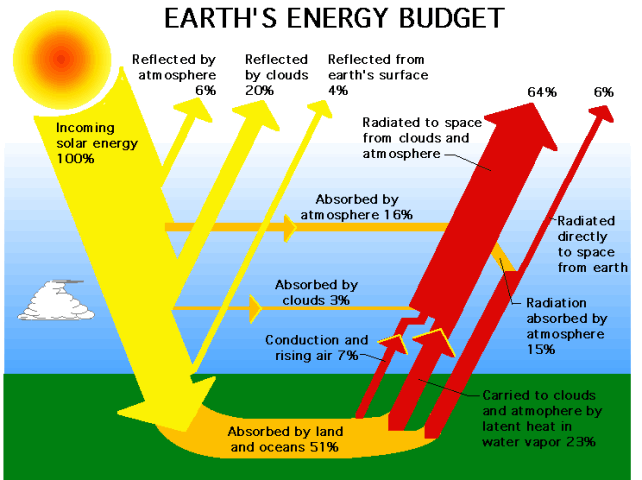 a
mass of cold air above your plants it is normal for the heat in the ground to
levitate into the sky, hence radiational cooling. (Heat seeks cold in balance and vice versus) As the heat levitates it passes through the plant area. Now with a hay canopy a percentage of the heat is locked in and if you watered earlier in
the day you would have built up these welcomed heat units. Even on a 60
degree day at noon there are a lot of heat units to be garnished. So to
repeat that is the time perhaps around 11:A.M to do your watering. This
gives the plants a chance to dry and get over a little evaporative cooling, some
thing you don't need at 10 o'clock at night or in the early frosty morning if
you are going to turn the water off and go to bed. I know this is
repetitious from earlier in this feature but I can't stress this point enough so
bear with me, O.K. I am not an accomplished author as you can see.
a
mass of cold air above your plants it is normal for the heat in the ground to
levitate into the sky, hence radiational cooling. (Heat seeks cold in balance and vice versus) As the heat levitates it passes through the plant area. Now with a hay canopy a percentage of the heat is locked in and if you watered earlier in
the day you would have built up these welcomed heat units. Even on a 60
degree day at noon there are a lot of heat units to be garnished. So to
repeat that is the time perhaps around 11:A.M to do your watering. This
gives the plants a chance to dry and get over a little evaporative cooling, some
thing you don't need at 10 o'clock at night or in the early frosty morning if
you are going to turn the water off and go to bed. I know this is
repetitious from earlier in this feature but I can't stress this point enough so
bear with me, O.K. I am not an accomplished author as you can see.
Another feature of this hay by staying on the top of the plants you can keep it there during the days while the cold spell sticks around and not worry about it being packed around the plant.
There is some that migrates to the ground and serves as a nice mulch.
If you run into a warm spell you have the option of raking it to the side of the bed, or putting the excess into garbage cans or you can put it in contractor black plastic bags as I do when I run out of garbage cans. Throw a few moth balls in the plastic bags because it you don't the critters will take up residence in them.
My name is Bob Martino. My wife and I and a wonderful family operated Peacedale farms and roadside market a little south of Albany New York and fought Mr. frost for 40 years and we beat him most of the time.
This information is intended to heighten awareness of potential health care alternatives and should not be considered as medical advice. See your qualified health-care professional for medical attention, advice, diagnosis, and treatments.